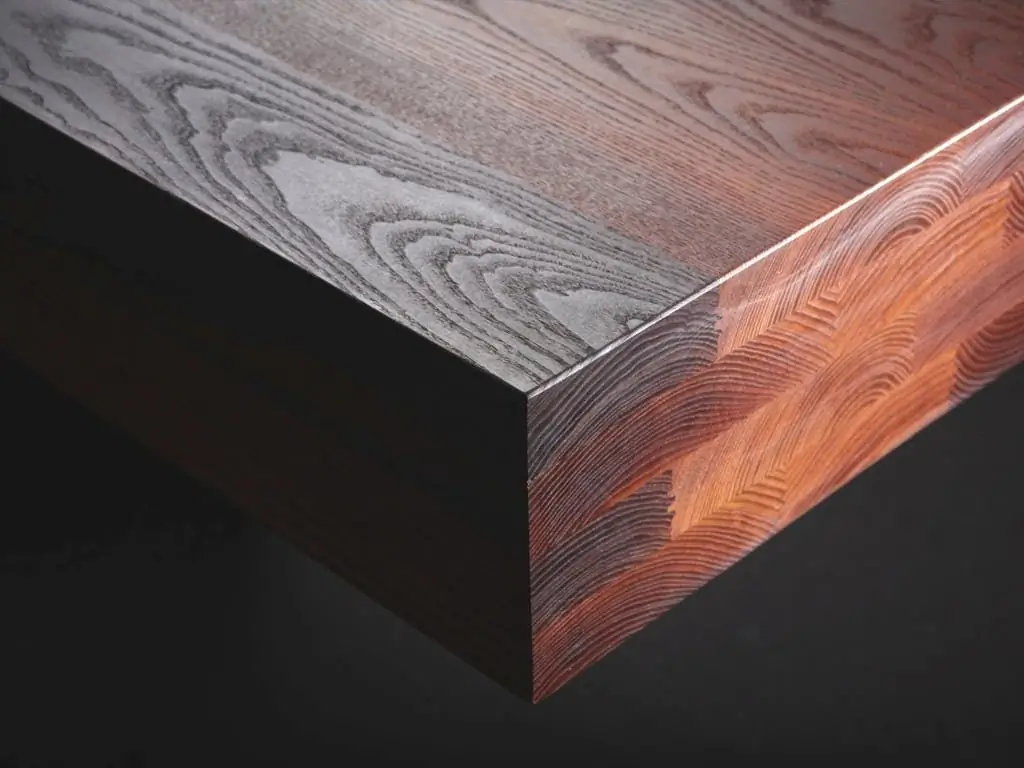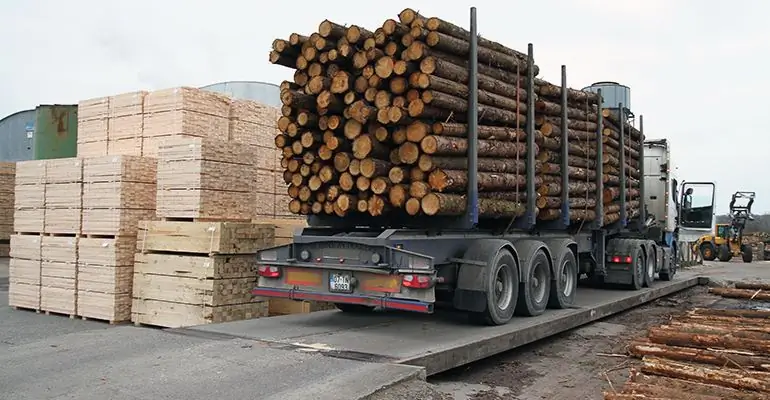2026 Author: Howard Calhoun | [email protected]. Last modified: 2025-01-24 13:10:27
Stabilized wood is a product obtained after a long and far from simple process of processing wood material. Stabilization is considered more of an art than a craft, as the craftsman has to apply all his experience, imagination and talent to make a truly valuable piece.

A solid wood with an amazingly beautiful pattern is formed as a result of long and painstaking work. The resulting material serves as the basis for spectacular and unusual knife handles, women's jewelry and various souvenirs. These items can be purchased for a hefty sum, or you can make your own.
Why stabilize wood
Any tree, even such strong and noble breeds as oak or ash, sooner or later is affected by various destructive factors. It wears out, deforms, absorbs moisture or, conversely, cracks. To extend the life of woodenproducts, they are covered with various impregnations, paints, emulsions and varnishes. These substances preserve the material, preventing premature wear and forming a dense protective layer on its surface.

Benefit of processed material
Wood stabilized does not require the application of any solutions, because it is thoroughly impregnated with special agents. Stabilization technology involves filling the pores and cavities of the raw material with a preservative substance, which, after hardening, turns the wood into a material with completely new properties:
- high density, hardness and strength;
- resistance to temperature changes and changes in humidity in the environment;
- total immunity to UV rays;
- the ability to stay in an open flame for a short time without loss of quality characteristics, changes in appearance and deformation;
- impervious to any oil;
- resistance to organic solvents.
Besides all of the above, stabilized wood is extremely beautiful. Transparent or colored impregnation emphasizes the natural pattern of wood fibers, sometimes creating incredible and magnificent patterns. The resulting material can be processed both manually and mechanically.

Methods of stabilization (preservation) of wood
On a large scalestabilized wood (you can see a photo of its samples in the article) is produced at specialized woodworking enterprises. Workers in such workshops use chemical solutions and impregnations of the required quality, in addition, they have access to the organization and adherence to the correct technology.
The tool used for the described process is:
- oil (often linseed);
- varnish;
- paint;
- polymer impregnation or resin.
The result of the work of professionals is not cheap, but those who want to get a product from such an unusual material should not be upset. There are several ways in which home craftsmen make a product similar to a factory one.
DIY stabilized wood can be made from raw materials with a beautiful grain pattern and a distinct texture. The best option is hardwood burl:
- birch trees;
- maple;
- elm;
- chestnut.
Kap is a growth on the branches, trunk or near the roots of trees, its fibers are closely intertwined with dormant buds. Burlap wood is considered quite an expensive material due to its density, rarity and beauty of the pattern.
Home-preserved wood is manufactured under the right temperature, vacuum and pressure levels.

How wood is impregnated
After selecting the right raw materials, the masterproceeds directly to the impregnation stage. Depending on the size and quality of the source material, as well as taking into account his abilities and preferences, he chooses one of several ways:
- Thin blanks can be impregnated at a fairly low temperature (cold impregnation).
- Hot impregnation. It consists in soaking or cooking the workpiece in special solutions. When hot, their consistency becomes more liquid, which helps the substance to penetrate into the fibers.
- Use of a vacuum chamber (pumping air out of wood cavities). This makes it easy to fill the freed capillaries and pores with an impregnating compound.
- Creation of excess pressure in the chamber, where a container with mortar and wood was previously placed. The process provokes the release of air from the fibers and the replacement of the vacant place with impregnation.
Wood stabilized: finishing, curing

The workpiece is polymerized by drying. Some types of compounds can be self-hardening, others have to be subjected to intensive drying at high temperature. Polymerized wood gets extra weight, new color and properties.
The result of the correct execution of this stage is stabilized wood. With their own hands (a photo of the finished sample is posted in the article), the wood is processed, as a rule, by those craftsmen who subsequently plan to sell the resulting material.
Often these craftsmen are engaged andproduction of exclusive wood products that are great as gifts and souvenirs. Stabilized wood is most commonly used for knives (handles), lighter and pen cases, jewelry boxes, and a variety of jewelry (beads, bracelets, medallions).

How to stabilize wood with Anacrol-90
This impregnation is optimal for home use, as it is quite easy to find, and fluidity allows the composition to penetrate into all pores of the workpiece. Some craftsmen prefer to use epoxy, but this is a more viscous and rather capricious remedy. Its successful application requires experience, patience and adherence to technology. Also, resin cannot be used on softwood.
To carry out the preservation of the wooden workpiece "Anacrol 90", you should prepare the following materials and tools:
- wood;
- impregnation;
- vacuum plant (to collect it, you need several large plastic containers, taps, plastic tubes);
- vacuum pump;
- compressor;
- a device that determines the force of pressure (pressure gauge);
- oven or aerogrill.
Small blanks (about 3 cm thick) are much faster and easier to impregnate. By the beginning of stabilization the tree should be dry.

How wood is preserved
It should be noted that the use of a clear solutionemphasizes the natural beauty of the wood, while the use of pigments or colored impregnations allows you to create a unique and unique pattern.
Work sequence:
- The tree is placed in a container with a solution, making sure that the liquid completely covers the workpiece.
- Exhaust the air until the air bubbles disappear.
- The impregnation is allowed to stand for about twenty minutes, after which an overpressure is created in the container (2-4 atm). This procedure requires the use of a compressor and pump.
- After a half-hour break, repeat the process.
Finish wood stabilization
To get a really high-quality material, you need to repeat the described procedure several times. The number of cycles depends on many factors (blank size, wood type, wood quality). The master can determine the degree of readiness of the stabilized workpiece by whether it sinks or floats in the solution. The impregnation was successful when the tree sank to the bottom.
Next, the workpiece is pulled out and dried in an oven or oven at a temperature of 100 degrees. You can judge how dry a tree is by looking at wet spots on its surface. When they are completely gone, drying can be stopped.
Treated wood becomes much denser, making it easier to polish and shape.

Knowing how stabilized wood is made, what it is and for what purposes it is used, you can do it yourselfmanufacturer.
This process is extremely exciting, it can please and surprise the patient craftsman with its results. Do not be afraid of failure, because, as they say, "the work of the master is afraid"!
Recommended:
Heat-treated wood: main characteristics, production technology, pros and cons

Almost every one of us has come across such a concept as heat-treated wood. However, few have thought about what it really means. Meanwhile, this material can be considered innovative. Due to the high temperature - from +150 °C to +250 °C - the material is strong and durable
Wood waste: main sources of formation and types of disposal

Humanity is seriously faced with the problem of waste disposal, so all over the world are developing more and more advanced methods of waste disposal. Recycling is now such a fashionable foreign word. In developed countries, resource conservation is an important motivation for wood recycling. How is it in our country?
Wood processing technology and production of wood products

Wood is an unusual and especially valuable material. For all its familiarity, it has an amazing set of technical and physical properties that a person cannot repeat with the help of synthetic substitutes. This is due to the extensive use of blanks made of natural wood in a variety of industries. Modern wood processing technologies and the production of wood products in general make it possible to provide people with furniture, building materials, decorations, utensils, etc
Production of olive oil and the cause of bitterness. Wood oil - what is it?

The European olive is an amazing tree with a lifespan of about 500 years! Moreover, its oils are endowed with a healing and simply beneficial effect. European olive oil is applicable in medicine. Often they relieve the symptoms of burns. In cosmetology, olive oil is used as a rejuvenating product of natural origin. We will also answer the question: wood oil - what is it?
Beech density. Features, application and technological properties of wood

Beech is one of the most common tree species found in mixed and deciduous forests across much of Europe. It is widely used in the manufacture of furniture. Its wood has great strength, toughness and inelasticity. The density of beech, which will be discussed in the article, depends on the cellular structure and humidity

